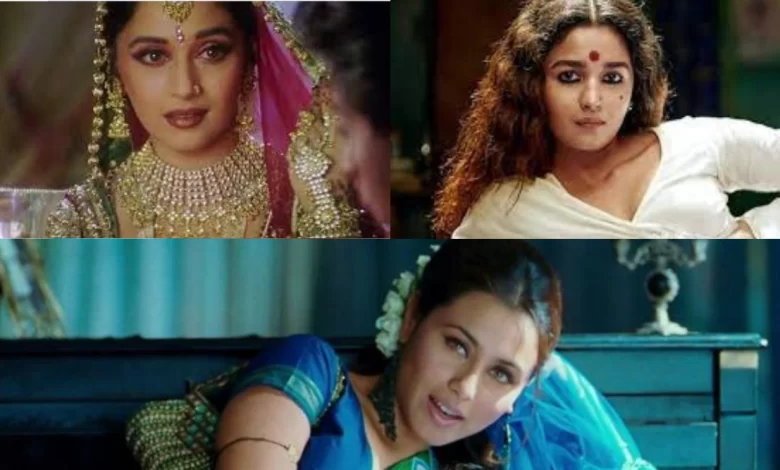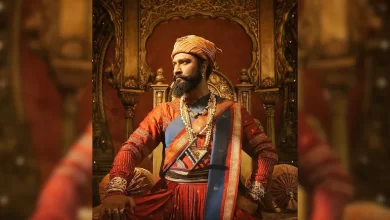
From Devdas’ Chandramukhi to Gangubai Kathiawadi and Heeramandi: The courtesans of Bhansali
As Heeramandi starts shooting, here is looking at Sanjay Leela Bhansali and his depiction of courtesans – from Devdas’ Chandramukhi to Gangubai – in a career that spans more than two decades
Cinematographer and a long time associate of the Sanjay Leela Bhansali, Sudeep Chatterjee, recently took to the internet to announce the beginning of the shooting of the director’s highly anticipated, Netflix-backed project Heeramandi. A magnum opus set in the red-light district of pre-independence Lahore, the show will look at the stories of three generations of courtesans. Earlier, in a conversation with Variety, Bhansali described it as, “It is a huge saga about the courtesans of Lahore, it is something I was living with for 14 years. It’s very vast and ambitious.”
Although the details surrounding the project are still under wraps, Manisha Koirala, Richa Chaddha and Aditi Rao Hydari are slated to play pivotal roles in the film. As per reports from Bollywood Hungama, veteran actress Rekha is also in ‘advanced talks’ for a seminal role, written specially for her, in the eight-episode series, which will have approximately hour-long episodes. Bhansali’s first venture into the digital world, Heeramandi does not have a release date yet.
But the subject of courtesans is not something new in the universe of Bhansali, who has repeatedly returned to the figure of the prostitute – turning it almost into an archetypal trope across several of his works. In a recent interview, Anupama Chopra asked him about how his childhood growing up in a chawl next to a red-light district endeared him so deeply to the figure of the sex worker. Bhansali responded, “We would see them on our way back from school everyday…but it was not something you could ask your mother about on the dinner table. Their faces had tremendous stories, they made themselves up with paint and powder…but how can you camouflage the grief? These are moments that for me as a film-maker matter.”
One immediately remembers one his earliest films, Devdas which shot him into overnight international fame. The film, based on Saratchandra Chattopadhyay’s novella of the same name, looked at the doomed love story of Devdas, his childhood love-interest Paro and Chandramukhi, a courtesan Devdas encounters following his separation from Paro. The first time we meet Chandramukhi, she is resplendent in a wine-red ensemble, performing to the beats of Kahe Ched More – a song drenched in the principles of coquettish seduction from the ancient Indian texts on sringara. But once she meets Devdas in person, she is stripped to a bare white. The colour of her clothing now forces us to reckon the internal purity of her being – something that her profession overrides. The fact that she is a force of nature itself is driven home by two successive shots of her flipping her hair and cracking a mirror and a transition shot of the moon being in the sky gently grazed by streaks of clouds.
Although the latter half of the film gives Bhansali ample scope to feed her dialogue that allows her to establish her own right as a woman first, and a sex-worker later – the beauteous simplicity of these shots are nothing short of establishing key points of her character. She is a woman who sells love each night until with the arrival of Devdas, with whom she falls headlong in love – a sensation hitherto unknown to her. Subsequently in the famous Hum Pe Kisne Hara Rang Daala, she asserts her right to love, and be loved back. This time Bhansali dresses her in an emerald green – the very colour of sringara itself.
Bhansali has on multiple occasions cited Guru Dutt as one of his primary sources of inspiration, but whereas Guru Dutt had always sought to establish a nihilist worldview through his deployment of the figure of the prostitute in films like Pyaasa and Kaagaz Ke Phool, Bhansali brought an almost operatic, campy aesthetic to his vision of the woman in the sex trade. His purpose was no longer an interrogation of cityspace – fast giving way to moral degeneration and corruption – but rather a larger inquiry into politics of womanhood itself. Chandramukhi’s character not only demands love but also the right to refuse her services in the face of disrespect – something that becomes apparent in her stunning monologue following the Durga Puja celebrations at Paro’s residence.
But despite the difference in treatment, what is similar in the works of both these auteurs is the deep rooted empathy they both feel towards the figure of the prostitute. Yet another striking example of the same from the oeuvre of Bhansali is the character of Gulabji in Saawariya. If her name was not enough, this character played by a pitch-perfect Rani Mukherjee is always to be found with a rose in her hair. The colour of the blossom of course keeps shifting between a stark white and a deep red – depending on the setting. In her scenes with Raj, whom she takes a liking to, she sports white roses – showing the deep seated innocence of the bond these two lost souls share in this “khwabon ka sheher”. But in the scenes where she is fetching customers on the streets, the roses change colour to a deep red. Here there is no denying the reality of her profession – or the pain it leaves in its wake.
What is even more interesting is how Bhansali, almost playfully, makes Gulabji the narrator of the film – whose opening lines clearly establish that this is a story set in the deepest realms of fantasy. Is this all happening in reality? Or is this just a figment of Gulabji’s own imagination? We are never allowed to have a definite answer – even as the film veers into the territory of tragic anti-romance with the separation of Raj and Sakina. But yet again, Bhansali imbues his prostitute with tragic dignity. The cost of denying sex to a heartbroken Raj is permanent separation from him for the deeply lonely Gulabji – a price she willingly pays for her own personal dignity.
Although Bhansali touched upon the idea of the courtesan as a gatekeeper of the performing arts with Bajirao Mastani, it was only with Gangubai Kathiawadi that Bhansali realised his first full-length feature of the life of a prostitute. With the character of Ganga, who goes on to become Gangubai, Bhansali found the perfect balance between his need to tell a real story and yet colour it with his larger-than-life vision. But while a lot of credit does go to Alia Bhatt for essaying a role many people doubted her ability to pull off, one needs to see this film also as the realisation of a long-term directorial vision.
In the initial sections of the film, Ganga only dresses in deep shades of maroon and purple. But after she is sold off, and soon becomes the madam of the brothel herself, she only drapes herself in shades of white. In one of the most beautiful sections of the film, which the costume designer Sheetal Iqbal Bano said in an interview was inspired by an actual conversation they had with Bhansali, Gangubai speaks to her lover Afshan about the many shades of white. The colour white, with its many shades eventually becomes an extended metaphor for the persona of the prostitute herself – she is a shorn lover, a fierce friend, a mother in spirit and a woman rooted in a sense of fierce independence. Bhansali and his obsession with poetic purity is best seen in his desire to juxtapose the supposed impurity of the profession with the purity of character, Gangubai espouses. This is a purity that is far removed from ideas of sexual chastity but rather one that constitutes a purity of dreaming and pining for the promise of a better future that hardly ever seems to arrive.
In her establishment shots, we first hear her voice – explaining her relevance in the Kamathipura neighbourhood with the aid of cosmic metaphors. We first see her feet propped up on the seat of her car. We next see her swaggering her way to her destination. When we finally get a close-up shot of her face – Bhansali frames it against a window, giving the impression of an almost-halo. This is a woman who is more than a regular hero and nothing less than a goddess.
But the closest a prostitute character comes to depicting the depth of Bhansali’s empathy for this tribe, is the unnamed character of Huma Qureshi – who we see performing in Afshan’s wedding. As she dances to tunes of Suna Hai Ki, she is not just speaking of the pain Gangu undergoes over the course of arranging Afshan’s marriage – but rather the plight of every woman in the world who are forced to associate their worth with a transactional sum. One remembers the poetry of Chandramukhi in the same regard and the stunningly choreographed song sequence Chhabelee from Saawariya – both of which were a deep dive into the pain of prostitution.
Often criticised for the flamboyance of his vision as opposed to perhaps a more gritty approach that might benefit such topics, what most people fail to realise is the empathy with which Bhansali almost pathologically views the pining and pain of these women trapped in these prisons of not their making. One can only but wait with bated breath for Heeramandi next!
News Source:- The Indian EXPRESS





